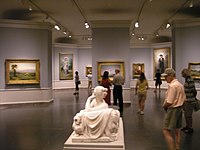Stonewall Jackson......a code for masons?? Stone wall............Alex Pope........Rome..............Italy....Vatican City.....................where the Pope lives.............J R Pope.........and American who designed the West Gallery of Art........and the Tom J Memorial....................after Stonewall J and Rob E Lee......what is next said our New Yorker President.............Geo Washington, Tom Jefferson........? It is all a big game to these people.......they do not respect shit unless there is money, sex or fame attached to it......i could care less about any of those 3...........................
Architecture[edit]
The museum comprises two buildings: the West Building (1941) and the East Building (1978) linked by an underground passage. The West Building, composed of pink Tennessee marble, was designed in 1937 by architect John Russell Pope in a neoclassical style (as is Pope's other notable Washington, D.C. building, the Jefferson Memorial). Designed in the form of an elongated H, the building is centered on a domed rotunda modeled on the interior of the Pantheon in Rome. Extending east and west from the rotunda, a pair of skylit sculpture halls provide its main circulation spine. Bright garden courts provide a counterpoint to the long main axis of the building.
The West Building has an extensive collection of paintings and sculptures by European masters from the medieval period through the late 19th century, as well as pre-20th century works by American artists. Highlights of the collection include many paintings by Jan Vermeer, Rembrandt van Rijn, Claude Monet, Vincent van Gogh, and Leonardo da Vinci.
In contrast, the design of the East Building by architect I. M. Pei is geometrical, dividing the trapezoidal shape of the site into two triangles: one isosceles and the other a smaller right triangle. The space defined by the isosceles triangle came to house the museum's public functions. The portion outlined by the right triangle became the study center. The triangles in turn became the building's organized motif, echoed and repeated in every dimension.
The building's central feature is a high atrium designed as an open interior court that is enclosed by a sculptural space spanning 16,000 square feet (1,500 m2). The atrium is centered on the same axis that forms the circulation spine for the West Building and is constructed in the same Tennessee marble.[9]
However, in 2005 the joints attaching the marble panels to the walls began to show signs of strain, creating a risk that panels might fall onto visitors below. In 2008, NGA officials decided that it had become necessary to remove and reinstall all of the panels. The renovation was completed in 2016.[10]
The East Building focuses on modern and contemporary art, with a collection including works by Pablo Picasso, Henri Matisse, Jackson Pollock, Andy Warhol, Roy Lichtenstein, Alexander Calder, a 1977 mural by Robert Motherwelland works by many other artists. The East Building also contains the main offices of the NGA and a large research facility, Center for Advanced Study in the Visual Arts (CASVA). Among the highlights of the East Building in 2012 was an exhibition of Barnett Newman's The Stations of the Cross series of 14 black and white paintings (1958–66).[11] Newman painted them after he had recovered from a heart attack; they are usually regarded as the peak of his achievement.[citation needed] The series has also been seen as a memorial to the victims of the Holocaust.[12]
The two buildings are connected by a walkway beneath 4th street, called "the Concourse" on the museum's map. In 2008, the National Gallery of Art commissioned American artist Leo Villareal to transform the Concourse into an artistic installation. Today, Multiverse is the largest and most complex light sculpture by Villareal featuring approximately 41,000 computer-programmed LED nodes that run through channels along the entire 200-foot (61 m)-long space.[13] The concourse also includes the food court and a gift shop.





No comments:
Post a Comment